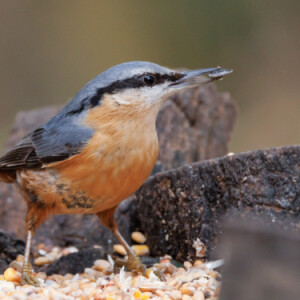Coal tit
I got a few useful things done this morning, then decided to reward myself with an hour in Hillers' bird hide. The light was awful for most of the time I was there, but the site has been cleaned up since I last saw it and a lot of food had been put out, so there were plenty of birds to photograph in the gloom. Someone who turned up when I'd been in the hide for a while asked (in time-honoured fashion) if there was much about. "Well," I said, "just the usual suspects really," but when I then rattled off a list of the things I'd seen, we were both surprised by how many species it included.
This was the first real birding test I've been able to set for the R5 and the 100-500 lens, and given today's conditions I'm absolutely delighted by the way they performed. Numerous shots I assumed I'd missed, of birds I could barely see, turned out amazingly well, and the failures mainly came down to operator malfunction or a too-slow shutter speed. I've chosen to feature this photo of a coal tit, despite the messy bird table background, partly because I love coal tits and partly because it's R's favourite of the images I showed him tonight, but also because it's one of the shots I thought I'd fluffed, and was astonished to find was sharp. All I managed to do in the split second during which the bird was still was get it in the frame and press the shutter button - the camera did everything else except process the file.
Another surprising bird table success was the nuthatch I've added as an extra, which was zooming in and out, as they do, grabbing its favourite sunflower seeds and carrying them away to cache them in nooks and crannies around the site. Coal tits also cache food, which is one reason why they're as successful as they are at surviving even harsh winters, but they're much less showy and overt about it than nuthatches.
This nuthatch (or at least, a nuthatch - I can't be sure that there was only one present today) was especially fond of using a large tree stump a little way from the hide for hiding its food, but it made such a performance of it that it might as well have stuck little red flags by all the hiding places: every time it went away for a while, squirrels, chaffinches, and even a coal tit went around the stump and tried to dig out its cached seeds. Luckily for the nuthatch, none of them was equipped with the same length of bill as it has, so I think they were mainly frustrated - though again, it's interesting to note that the coal tit has the narrowest bill of all our native tit species, and the ability this gives it to winkle invertebrates out of tiny crevices, and extract the seeds from pine cones, is another reason for the species' success.
There's a set of images here of the nuthatch looking for the perfect hiding place for a sunflower seed, if you'd care to take a look.
I'll leave you with one more fun fact about the coal tit: the slightly ruffled appearance of its head feathers in this photo wasn't caused by a breeze, but is a little crest - usually inconspicuous - which it raises when alarmed. There's a bird in the north of the Indian subcontinent called the black-crested tit, which is much more extravagantly equipped in the headgear department and used to be thought of as a separate species, but which is now considered to be a sub-species of the coal tit.


Comments
Sign in or get an account to comment.


